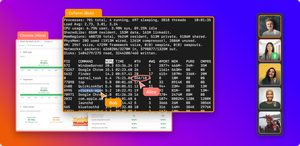As many of us have been forced to leave our open office floor plans and aquarium-like meeting rooms in favor of work from home, so has our search intensified for ways to replace that "side by side" physical experience. But what does it even mean to work side by side in a virtual context and is it something we should actually strive to replicate to begin with?
According to Merriam-Webster it can be defined as
- beside one another // walking side by side
- in the same place, time, or circumstance // lived peacefully side by side for many years

So far so good, but what implications does this have in an open floor work environment? Here are a few good and bad things I have experienced from working "side by side" over the years.
The good:
- I can easily get the attention of my colleague when I have a question
- There are few limits imposed on how we share information (passing notes, drawing on a whiteboard, talking)
- The social fulfillment (given that you like your colleagues)
- My body language adds to my ability to transfer a message or have a conversation
The bad:
- My colleagues can easily interrupt me when they have questions
- I have a hard time finding focus and need to "hide" in the office to get things done
- Many things I work on are still confined to my screen and thus not benefiting from physical proximity from a sharing perspective.
- Chatting gets in the way of work
The next best thing: video chat? Not so fast...
So here we are, confined to our home "offices" (i.e. garages, bedrooms, kitchen tables,...) while trying to work as a team without that physical proximity most of us are so used to. So what do we do? We try to find tools that replicate that. Hmmm, video chat must certainly be the next best thing here right? Like that I can both see and hear who I'm engaging with. Just like in an office! Wait, but why? Are we really harvesting those positive aspects of physical presence in doing so? Well, it depends on what you are trying to achieve.
A video chat does offer a downscaled version of side by side in creating a social experience that provides the ability to read each other's expressions and body language. Like a physical presence light.
However video chat doesn't provide that sense of turning the chair around to ask a question - After all you need to be in a session first and that only happens after you've scheduled a meeting or pinged someone through another medium (mostly chat).
It also doesn't offer the effective information sharing that comes from sharing work or output in a physical space.
But hold on! There is screen sharing!
Very true, but what key limitation does screen sharing have that has become as engrained in our minds like brushing our teeth in the morning? Well, it's not collaborative. And why is that? It can only go one way at a time!
It's like we are trying to replace that shared office or aquarium meeting room with a walkie talkie! Hello friend! Over! Hello, how are you? Over! Very well thanks! Over!... You get the gist. It gets very tiring to go back an forth like this. In fact so tiring that we normally just give up. For communication between two people or in a small group to be effective it needs to go both ways. So why have we left the concept of screen sharing in such a miserable state? Ok, in all fairness, things such as remote control does offer shared contribution, but you still have to decide who's the host and gets remote control rights. Why is that?
Wait, there some fantastic tools out there that have collaboration built in (Google Docs, Figma, Miro, VS Code, etc.)! Yes, but these experiences are optimized with an asynchronous workflow in mind and to work together in real-time you still need to connect over video or audio in parallel. And if you need to share something outside of these boxes, you're stuck with unidirectional presentation tools again.
To be clear, I'm not at all arguing against the use of video chat. On the contrary I use it all the time when I believe that social component is important. However, there are other aspects of "side by side" that we should try to mimic or enhance when we looking at remote team productivity.
This brings me to the aspect of getting actual work done together.
What it really means to work side by side
To really work side by side there needs to be a conversation. And that conversation happens involves the material you are working on, not just your voice and face. The old screen sharing walkie-talkie model comes with constraints that go against our very nature as human beings and becomes a hindrance to stay effective. In a work-from-home context we expect almost all work to be done in-between meetings rather than during them.
At CoScreen we want to turn this decades old assumption of screen sharing on its head. What happens when you make the work you do the actual conversation? The list of use cases can be made long and that's because effective communication is key to success in many areas and contexts.
How we're using CoScreen to build CoScreen
Here are a few examples of situations I found myself it really made a difference:
- Compare side-by-side: My co-founder and I had a discussion on Slack over the font size on our website. After waisting too much time passing messages we jumped on a CoScreen session only to realize that what I was seeing was somewhat off. Turns out I had accidentally fiddled with the Zoom level in Chrome 🤦♂️.

- Augment the meeting: Between three team members we were working through our product roadmap and as is common between passionate people we sometimes had disagreements on what to work on next. With CoScreen those arguments could be settled faster as additional pieces of information (product analytics, server stats, online resources, ...) could quickly be shared by any of the participants to make a point. In a one-way screen sharing setup we wouldn't even have bothered to share all of this material and would have left the session in disagreement.
- Coach and train: I found myself in a situation where I had to connect direct to a database to extract some additional usage statistics. The problem was that this was all new to me and not super intuitive. I started a conversation with one of our engineers in Slack, but it quickly became clear to me that I needed some 1-to-1 support to get started. Using the /coscreen Slack command we got a session and I could show myself trying to connect over SSH and running an SQL command while he was in turn showing me exactly what he was doing and it became obvious to both of us where there had been a misunderstanding.
To conclude, creating a virtual side by side experience is all about what your are trying to achieve. Sometimes video chat with simple screen sharing is the right modality, but not if you want to get something done in a natural, seamless way.
While CoScreen is currently in Private Beta you can sign up to our waitlist for early access or our join our mailing list to stay informed of our upcoming public release.
Happy CoScreening!





